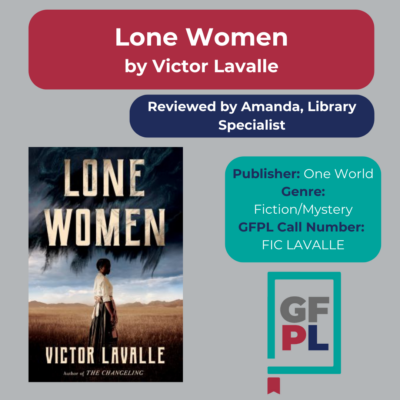Note: Starting in January 2025, we began publishing long-form book reviews written by GFPL staffers. The books are all available to check out at the Library, or from one of our Partner Libraries. We post a new review each month! Come back next month to find the next review.
‘Lone Women’ a genre-bending tale written by a master Montana-based storyteller
Review by Amanda, Library Specialist
Book by Victor Lavalle
 It is 1915 and Adelaide Henry sets out for Montana the day after her parents are slain on their farm in the Lucerne Valley, California. In a wagon headed to the Port of Los Angeles, and sailing up the coast to Seattle, Adelaide contemplates the life and the people she is leaving behind. The secrets, and aphorisms from her mother ring in her ears. She recalls being a dutiful daughter, but through it all, “The reward for sacrifice is simply more sacrifices.”
It is 1915 and Adelaide Henry sets out for Montana the day after her parents are slain on their farm in the Lucerne Valley, California. In a wagon headed to the Port of Los Angeles, and sailing up the coast to Seattle, Adelaide contemplates the life and the people she is leaving behind. The secrets, and aphorisms from her mother ring in her ears. She recalls being a dutiful daughter, but through it all, “The reward for sacrifice is simply more sacrifices.”
Before Adelaide began her quest, she found an article from a 1913 Montana newspaper, a testimonial of a “lone woman” who had a flourishing homestead, and called Montana, “a land of unlimited opportunities”. This became Adelaide’s lifeline of hope. She arrives in Seattle, finds a real estate salesman, and stakes her homestead claim for a property near Big Sandy, Montana.
The Homestead Act of 1862 stated that any United States citizen who had never borne arms against the U.S. Government could claim 160 acres of land, if they stayed on the land for five years and improved it. This act did not exclude women or people of different races enabling many a chance they had previously never dreamed of.
Adelaide arrives in Big Sandy, population around 500, a much larger concentration of people than in the area she was from, but somehow it all seemed smaller, “the flat expanses of Montana had floored her as she scanned the state from the train”.
As her homesteading journey begins, Adelaide meets friends and foes. She is brought to the realization that if she wants to lead a different life than the one she previously had with her parents, she has to open up and trust her new-found friends, other “lone women” who are trying to make their own lives in a harsh society and landscape. Montana is an environment that, as one character accurately states, “This land is trying to kill every single one of us.”
As the story unfolds, the eerie suspense and horror elements build until finally in one swift and ferocious scene you learn the secret that Adelaide and her parents had been keeping. Other characters have been keeping some pretty dark secrets as well. With time they come to light and help to draw all the threads of the plot together.
All of Victor Lavalle’s characters in this novel are vibrantly brought to life; you feel as if you know these people. Adelaide herself is a complex, intricately drawn character. She is multifaceted, and three dimensional. Her frailties, growth, and truth are personal and unique, yet in many ways universal. Adelaide’s family’s secret brought so much shame and isolation on her that she wonders about what she calls her curse “Maybe the silence is the worst part of this suffering.”
The author does a superb job of bringing the landscape to life as well. From the wind being a nearly living thing, through most of the seasons in this part of Montana, the way it can wear a person down, to the deadly cold, and the relentless, parching heat in the summer. I loved the factual details spread throughout the story, such as the kilns at Glendale, MT. You can still see them today as part of the little that remains of the once booming silver mine area.
From page one I was drawn into the story, and my interest never waned throughout the book. This novel does not fit into one genre smoothly. It has horror and elements of magical realism, while being a work of western historical fiction, and yet it could be said that Lone Women is a tale of friendship and resilience. The author is a master storyteller, with depth and skill.
I will not soon forget Adelaide and her friends, the lone women, who lived their lives on their own terms.

